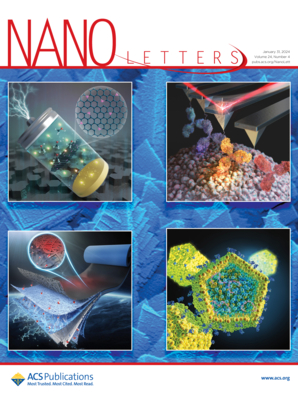Integrated Methodology from Synthesis to in Vivo Study that Identifies Nanostructure Shape “Hot Spots” in T Cell Receptor Repertoire
IF 9.6
1区 材料科学
Q1 CHEMISTRY, MULTIDISCIPLINARY
引用次数: 0
Abstract
A new integrated tunable microfluidic particle synthesis and shape population analysis workflow allows us to study the immunological readouts for even highly complex shaped nanoparticles. Using this approach, we demonstrate that some gold nanoparticles, when injected parenterally, are taken up by axillary and brachial lymph nodes. We then show that specific nanoparticle shapes influence the primary structure of the T cell receptor, inducing changes in hypervariable complementary-determining regions (CDRs) and increasing the clonal diversity of the T cell receptor repertoires. These same particles were previously found to modify cellular epigenomes and elevate the level of autoantibodies. Our results are consistent with other emerging reports that precisely controlled nanoarchitectural features are recognized and captured in multiple tiers of biology, with potential implications for vaccine adjuvant design. Our conclusions may also be relevant to an extensive legacy of poorly understood epidemiological studies, suggesting links between some pollutant particulates and complex forms of immune dysregulation and autoimmune diseases.

从合成到体内研究的综合方法,识别 T 细胞受体汇聚中的纳米结构形状 "热点
一个新的集成可调微流控颗粒合成和形状种群分析工作流程使我们能够研究即使是高度复杂的形状纳米颗粒的免疫学读数。使用这种方法,我们证明了一些金纳米颗粒,当经肠外注射时,被腋窝和肱淋巴结吸收。然后,我们发现特定的纳米颗粒形状会影响T细胞受体的初级结构,诱导高可变互补决定区(cdr)的变化,并增加T细胞受体谱的克隆多样性。这些相同的颗粒先前被发现可以修饰细胞表观基因组并提高自身抗体的水平。我们的结果与其他新兴报告一致,即精确控制的纳米结构特征在生物学的多个层面上被识别和捕获,对疫苗佐剂的设计具有潜在的意义。我们的结论也可能与流行病学研究的广泛遗留问题有关,这些研究表明某些污染物颗粒与复杂形式的免疫失调和自身免疫性疾病之间存在联系。
本文章由计算机程序翻译,如有差异,请以英文原文为准。
求助全文
约1分钟内获得全文
求助全文
来源期刊

Nano Letters
工程技术-材料科学:综合
CiteScore
16.80
自引率
2.80%
发文量
1182
审稿时长
1.4 months
期刊介绍:
Nano Letters serves as a dynamic platform for promptly disseminating original results in fundamental, applied, and emerging research across all facets of nanoscience and nanotechnology. A pivotal criterion for inclusion within Nano Letters is the convergence of at least two different areas or disciplines, ensuring a rich interdisciplinary scope. The journal is dedicated to fostering exploration in diverse areas, including:
- Experimental and theoretical findings on physical, chemical, and biological phenomena at the nanoscale
- Synthesis, characterization, and processing of organic, inorganic, polymer, and hybrid nanomaterials through physical, chemical, and biological methodologies
- Modeling and simulation of synthetic, assembly, and interaction processes
- Realization of integrated nanostructures and nano-engineered devices exhibiting advanced performance
- Applications of nanoscale materials in living and environmental systems
Nano Letters is committed to advancing and showcasing groundbreaking research that intersects various domains, fostering innovation and collaboration in the ever-evolving field of nanoscience and nanotechnology.
 求助内容:
求助内容: 应助结果提醒方式:
应助结果提醒方式:


